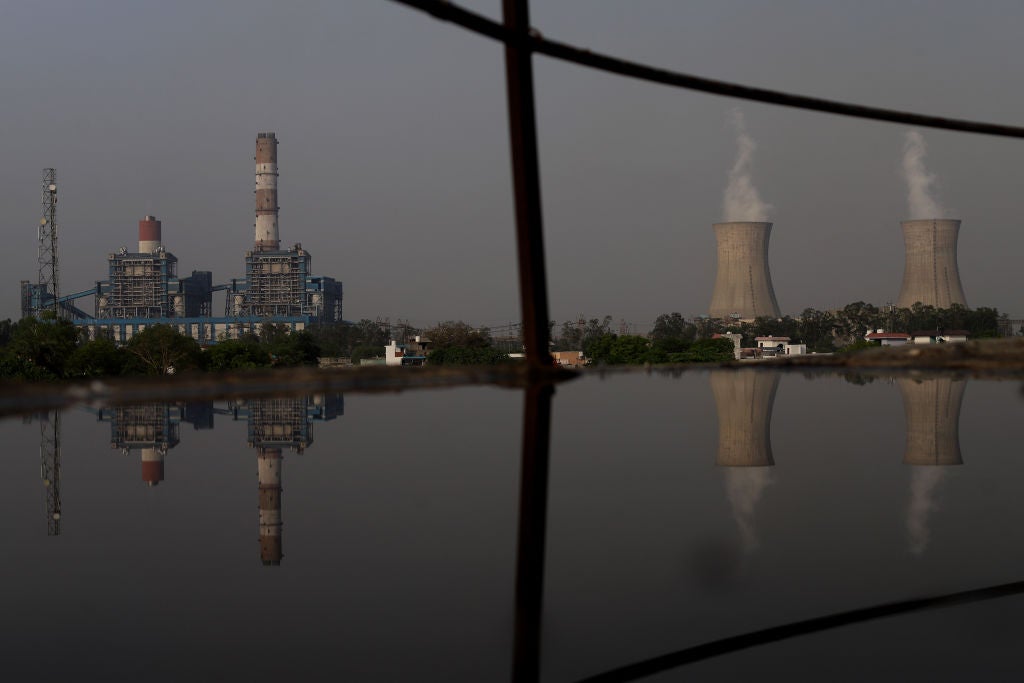
A planned national carbon market for India, the world’s third-largest emitter, could become one of the biggest mitigation experiments ever attempted, getting the country on track to meet its net-zero greenhouse gas emissions goal by the promised date of 2070.
As part of its updated commitment under the Paris Agreement, the country aims for non-fossil fuels – solar and wind but also large hydro, which until recently was not classified as renewable due to its environmental impacts, and biomass – to make up 50% of its power generation capacity by the end of the decade. Yet India is struggling to dial back its dependence on fossil fuels, with coal still providing around 70% of total power generation.
To drive down fossil fuel use, India is now eyeing a national carbon market. In its most recent energy bill, the Indian government green-lighted the creation of a “carbon credit trading scheme”, whereby polluters exchange credits equivalent to a certain amount of emissions. According to the bill, the government will issue carbon credits to entities such as businesses or other institutions that choose to register under the scheme. Scheme members will be free to sell and buy credits to meet their individual carbon budgets.
The carbon market will be voluntary at first, although the plan is to follow with the roll-out of a mandatory cap-and-trade system. This means the government would set an overall emissions cap and issue a corresponding number of credits that members could trade between them.
See Also:
“A carbon market creates an incentive for more sectors and individual corporations to transition [to low-carbon fuels and operations],” says Vibhuti Garg, an energy economist at think tank the Institute for Energy Economics and Financial Analysis (IEEFA). Companies that find it hard to decarbonise their operations for lack of capital can still meet their climate goals by buying carbon credits on the market, she adds. Micro, small and medium enterprises (MSMEs) are one example.
MSMEs account for around 45% of India’s manufacturing output and 40% of its exports. While their largely informal nature makes it difficult to estimate their carbon footprint, a 2016 inventory found the sector is responsible for roughly 6% of India’s total emissions.
How well do you really know your competitors?
Access the most comprehensive Company Profiles on the market, powered by GlobalData. Save hours of research. Gain competitive edge.

Thank you!
Your download email will arrive shortly
Not ready to buy yet? Download a free sample
We are confident about the unique quality of our Company Profiles. However, we want you to make the most beneficial decision for your business, so we offer a free sample that you can download by submitting the below form
By GlobalData“There are several companies in India who are very willing to invest in [emissions reductions for] carbon trading, but they are not getting good prices on the international market, so it was decided to develop an indigenous carbon market,” says Abhinav Trivedi, an energy consultant with NITI Aayog, the government’s primary public policy think tank and policymaking agency that brings together all states. The agency is already working on a framework that will flesh out the idea.
That draft should be published before the end of the year, Trivedi says. “We are starting with the major polluting sectors, such as power, steel, cement and other heavy industries, and over time we will include smaller industries too,” he explains.
Researchers at MIT have found that the way energy-intensive industries are managed in the coming decades could make or break India’s decarbonisation ambitions; emissions from its hard-to-abate sectors are expected to grow 2.6 times by 2050. Carbon pricing that makes carbon capture and storage technologies economically viable is critical, the MIT study says. Without this, decarbonising India’s heavy industries – and reaching net zero by 2070 – will be impossible, the researchers warn.
The Indian government wants to develop homegrown technologies that can deliver emissions reductions and underpin credits in the new national carbon market. “We could directly import carbon capture technologies from Europe or the US, but that wouldn’t be cost-effective for us,” Trivedi says. The plan is to devise specific technological solutions for each carbon intensive sector targeted by the carbon market. Then "industries can cash in on the market itself”, Trivedi explains.
India's carbon market experience to date
India is not new to carbon pricing experiments, albeit on a smaller scale. Until 2017, it had a tax on coal production, the coal cess, and a Perform, Achieve and Trade scheme (PAT), which rewards energy-intensive industries that improve their energy efficiency. Renewable Energy Certificates are another way for Indian businesses to earn and trade credits based on their renewable energy production.
Most recently, the western state of Gujarat announced it will roll out its own carbon market, based on the success of a previous cap-and-trade scheme for particulate air pollution. The latter, which covered industrial clusters in the city of Surat, has been able to reduce particulate matter emissions by 24% since its launch in 2019. The planned carbon market is expected to cover around 120 emissions sources in the state of Gujarat, including both industries and the power sector. With an estimated 227.4 metric tonnes emitted in 2018 alone, energy is the most polluting sector in Gujarat, which ranks third among India's states for its carbon emissions.
Rohini Pande, an economist at Yale University in the US who helped design the particulate air pollution scheme, explains that setting up a market for carbon emissions will be easier than it was for particulates, because all you need to start is an inventory of emissions from a finite list of point sources, rather than having to monitor particulate emissions across diffuse sources, from agriculture to vehicles to industrial production chains. While robust carbon emissions inventories can be hard to create and maintain, India has gained experience through its past emission trading schemes, and can build on that.
“You are going to need an emissions inventory,” Pande says. This can be drawn up from known variables such as fuel use data and quantified using standardised methods, she adds. Nevertheless, for developing nations, creating these comprehensive inventories tends to be a challenge. “One of the main issues [for India] will be to identify the institutions that can provide [or verify the veracity of] this kind of reliable data,” Pande notes.
“While there is a mandate in terms of business responsibility and reporting, not all companies are disclosing their emissions,” says the IEEFA’s Garg. “There is definitely a lack of data, and that is why the Reserve Bank of India is pushing hard to come up with a disclosure framework similar to the Task Force on Climate-related Financial Disclosures.”
Some of the biggest companies in the country have already set up monitoring facilities to count their emissions, something they will need in order to do business with international partners, Garg explains. However, small businesses cannot afford this kind of additional expense without passing the costs on to their customers, which would mean losing out to the competition.
The international significance of an Indian carbon market
“Globally, the establishment of a carbon market in India means a lot for the climate, because India is a large country and a large emitter overall,” says Andrea Bonzanni, international policy director with the International Emissions Trading Association. “India is also seen as a potential large provider of carbon credits to other countries that may want to meet their targets with emission reductions originating abroad, or for companies that are looking to purchase international credits on the voluntary market.”
When India's Minister of New and Renewable Energy RK Singh initially said that all carbon credits generated by a new national carbon market would be used domestically, ripples of concern spread through international carbon markets. He later clarified that while domestic markets would be prioritised to help India meet its Paris climate goals, sales abroad would also be permitted.
With more than 1,000 projects registered under the UN Clean Development Mechanism, India is currently one of the world’s biggest exporters of carbon credits. However, a lack of robust monitoring has sometimes led to credits being generated by projects of little environmental value. In the capital Delhi, a controversial waste-to-energy plant has collected carbon credits for years despite being under fire for polluting air and soil with toxic emissions and discharge.
“Since the approval of the Kyoto Protocol, many companies and countries have been trying to evade responsibility and fudge numbers,” NITI Aayog’s Trivedi says. “That is why we are designing a framework that is stringent and has no loopholes. We are learning from past failures seen elsewhere in the world.”
[Keep up with Energy Monitor: Subscribe to our weekly newsletter]
Through trial and error, carbon markets are expanding across the globe, Bonzanni says, both in geographical scope and in terms of sectors covered. “Then last year [at COP26] in Glasgow we had a game changer with the agreement on Article 6 [of the Paris Agreement],” he adds. This article, which regulates the international exchange of carbon credits, “is expected to open up a new international compliance market and opportunities for linkages between the different national regimes”, he says.
Garg is more cautious. “I don't think [a potential Indian carbon market] can be harmonised with other international markets just yet.” Carbon prices have gone up in Europe, but India is not yet at that stage of development where it can absorb such high prices, she says. Garg believes a future voluntary carbon market in India could initially involve industries that export products to heavily regulated markets and have a business interest in abating their emissions.
One example is the steel industry, which has strong ties to the European market. Under the EU's proposed Carbon Border Adjustment Mechanism, companies importing goods into the bloc will have to pay for the carbon emissions resulting from their production. Carbon-intensive Indian steel could become more expensive – and thus less competitive as a result. For local steelmakers, the decision to reduce the sector’s carbon emissions makes business sense.
“But for industries who cater to domestic markets there is no way you can pass on that increase [in the cost of production] to customers," says Garg. "A fully fledged carbon market is going to take a while.”
Editor's note: This article was corrected after publication to reflect Rohini Pande's correct affiliation.







